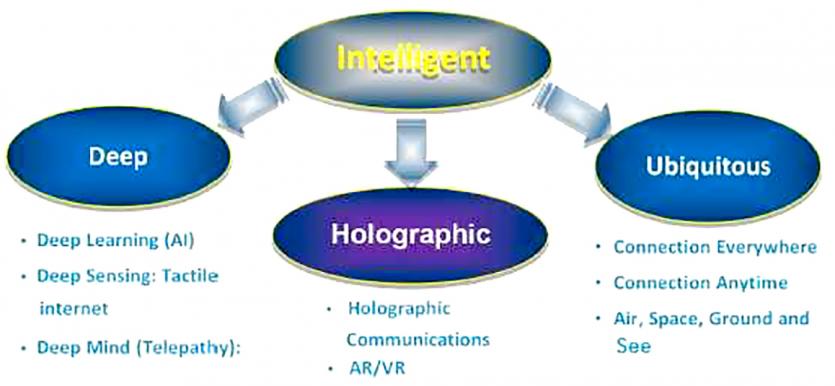6G wireless network, The Advantages And Disadvantages
In this article, we intend to briefly examine the pros and cons and the underlying technologies that allow the implementation of a 6G wireless network.
What is a 6G wireless network?
6G refers to the 6G wireless network technologies. The research and development process on this technology started in 2019 to complete the achievements of 5G.
To be more precise, the research process on 6G wireless network began right at the same time as the widespread and commercial launch of the 5G network in April 2019. 6G wireless network entered the world of technology to respond to the respond requirements of businesses.
Among the principal axes on which 6G technology is focused, the following should be mentioned:
- Intelligent connectivity (infrastructure equipment uses artificial intelligence and machine learning to achieve such an achievement.)
- Deep connection
- Holographic connection (one of the essential goals of a 6G wireless network is more comprehensive coverage with the highest possible speed to respond to the requirements based on augmented and virtual reality.)
- Ubiquitous connectivity: This means that users in space, air, land, and sea do not have any problem connecting to the network.
Figure 1 shows the four main goals the 6G network seeks to achieve.

Figure 1
Regarding the 6G wireless network that is supposed to provide the highest speed and lowest latency, the goals go beyond home users or even business enterprises. The 6G wireless network seeks to realize the utopia of intelligent cities if not all equipment, but a wide range of them will be equipped with smart sensors to communicate with the network and each other.
To be more precise, the highest level of connection will be provided to us based on intelligence through these networks. Figure 2 shows this.
Let’s go back to the Qatar World Cup and Japan Olympics. We see that the companies active in the technology world use technologies such as 8K cameras, drones, virtual reality, and 5G networks in a limited way to cover the matches better.
All these technologies used the fifth generation of communication networks to send and receive information; in some cases, they used the mentioned technologies in a limited way.
More precisely, the goal was to test the technologies in a controlled environment to detect problems quickly.

figure 2
Figure 2 shows the architecture of the 6G network, which can cover all parts of the city through high-speed connections and the lowest delay rate. As shown, 6G communications are ubiquitous through satellites, Remote Radio Heads, Visible Light Communications, Base Stations, and 6G network equipment. It is installed on mobile devices and so on.
On the left side of the image, you can see the office building where the remote radio stations are deployed, providing the data needed by smart parking and self-driving cars via visible light communications while connected to the leading network.
On the lower left side of the image, you can see a factory where all equipment, such as surveillance cameras, lighting systems, door locks, and devices in production units, are managed through innovative technologies and connected to the network. So, remote radio stations tend to send and receive data to data centers.
Next, you can see the self-driving transportation system where the cars are passed, and intelligent traffic control systems monitor the activities.
Next is the sports stadium, where the drones enable accurate monitoring of the internal and external environment and send information to intelligent systems in real time to quickly identify suspicious cases.
To be more precise, in the future, remote monitoring systems will be able to identify people with a history of crime among this massive volume of spectators and send relevant reports to the authorities. In the center of the picture is a virtual cloud network where all the critical infrastructures needed for city management are placed.
This innovative public cloud-based network is equipped with monitoring centers, artificial intelligence systems, software-based networks, Mobile Switching Centers, Remote Radio Heads, and Optical Base Band Units, all connected as a private cloud network and serve different systems in the city. This network is interlaced with fiber optic internet.
The 6G network prevents city systems from being without internet even for a moment. On the upper right side of the image is a university campus, which, like other buildings in the city, is equipped with 6G and fiber optic networks, which provide users with the highest network access rates.
What are the advantages of 6G wireless network?
Among the advantages and disadvantages of 6G wireless network, the following should be mentioned:
These networks are designed to support the number of mobile connections more than the capacity of the fifth-generation communication networks so that they can cover more areas.
The 6G wireless network will revolutionize the healthcare sector; overcoming time and place challenges will ensure the possibility of performing remote surgery and optimizing the performance of the healthcare staff.
Today, remote surgery is performed in a limited way and in specific circumstances. Still, with the widespread emergence of 6G, this process will be used more widely in the medical world.
Statistics show that most mobile traffic is dedicated to home users. At the same time, the cellular networks that have entered the world of technology have never examined this issue in detail. 6G will overcome these problems using femtocells or Distributed Antenna Systems so that users can best use the benefits of 6G networks when interacting with technologies like Wi-Fi 7.
The 6G wireless network uses terahertz frequencies, which have several advantages. Terahertz waves can easily absorb moisture in the air, making it useful for short-range, high-speed wireless communications.
More precisely, it provides a powerful anti-jamming capability that makes it harder for hackers to break into these networks. Wireless bandwidths above several tens of GHz, from 108 to 1013 GHz, can provide higher terabit communication rates per second.
In space communication, terahertz waves are used to transmit information between satellites. Beamforming and efficient use of MIMO sharing technology to overcome signal attenuation and loss will allow better coverage requirements to be met on an urban scale.
It should be noted that the terahertz wave photon energy is deficient (about 10-3eV, which provides a higher energy efficiency). Terahertz waves can pass through materials better, so using them with special communication devices is possible.
6G networks use visible light to take advantage of the natural advantages of LEDs for high-speed data communications. VLC does not generate electromagnetic radiation, so it is not susceptible to interference from external electromagnetic radiation. In addition, VLC significantly improves network security.
The 6G wireless network makes the data transfer speed very high (Tb/sec) and the delay very low (sub-ms). Therefore, most industrial applications and services can use 6G wireless networks.
The 6G wireless network virtualizes additional components, such as the PHY and MAC layers. Currently, dedicated hardware is needed to implement the PHY/MAC layers. Virtualization reduces the cost of purchasing network equipment. This makes very dense deployment of 6G economically feasible.
What are the disadvantages of 6G wireless networks, and what challenges do they face?
While 6G wireless network have brilliant advantages, they have their challenges and disadvantages, the most important of which are the following:
Since this technology is under research and development, we cannot accurately assess its environmental harm. Until the network and equipment are concretely tested and installed, it is impossible to accurately measure the impact of waves on organisms.
6th-generation communication networks use cell architecture and multiple connections. Hence, a lot of time is needed to achieve integrated mobility and integration of communication channels of this network with different types of links (Hertz, millimeter waves, visible light communications, and sub-6 GHz waves). In cell architecture, the user equipment is connected to the distribution access network, not a cell. For this reason, a new architecture is needed to establish this communication.
6th generation communication networks use terahertz frequencies for part of their communication. Hence, the disadvantages of terahertz can be considered as the disadvantages of 6th-generation wireless technology. Terahertz frequency ranges between 0.1 and 10 terahertz with a wavelength of 30 to 3000 micrometers. Terahertz waves can be widely used in space communication, especially when establishing satellite communication.
In the terahertz frequency range, the waves increase so much that semiconductors can hardly control them. On the other hand, the energy of photons in this frequency range is so low that it is difficult to find a semiconductor whose energy gap is equal to the point of these photons.
In addition, the terahertz signal is susceptible to shadows (here, the cloud refers to obstacles that affect the propagation of the wave) and will affect the area it covers. In addition, the lower terahertz frequency creates a fading problem. Fading refers to the changes in attenuation of a modulated telecommunication signal when passing through a specific medium.
Fading may vary with time, space, or frequency and is modeled as a stochastic process. Because of this, 6G channels may experience fading. In wireless communication, fading may affect multipath propagation, mainly due to the shadow effect (obstacles that affect wave propagation).
Designing ultra-large-scale antennas is a significant challenge in the terahertz frequency spectrum, which requires high bandwidth and high resolution. The ability to perform processing is the main challenge in designing these antennas in a low-consumption and low-cost manner.
6th generation communication networks use visible light frequencies for part of their communication.
Hence, the disadvantages of VLC can be considered as disadvantages of 6th-generation wireless technology. Visible light uses a wavelength of 390 to 700 nm.
We need a new system to manage many terminals and network equipment more efficiently and with the lowest energy consumption. Network equipment circuits, airports, and communication protocol stack design must be reviewed to realize this.
Also, low-power chips are needed in electronic equipment such as IoT sensors and smartphones so that the battery does not drain quickly when the device is connected to the network. Therefore, some experts have predicted that there may be changes in the process of using batteries in consumer equipment.

